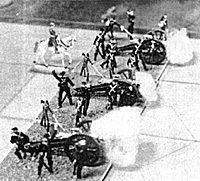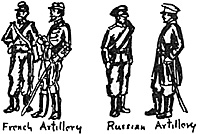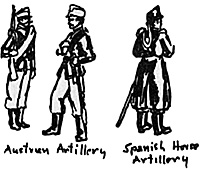 So far as equipment is concerned, no period in the history of artillery
saw such dramatic change as the period from 1850-1900. At the start, most
artillery was smooth bore, practically all muzzle loading. By 1896, the French
75mm field gun could throw out shells accurately at better than one round
every two seconds.
So far as equipment is concerned, no period in the history of artillery
saw such dramatic change as the period from 1850-1900. At the start, most
artillery was smooth bore, practically all muzzle loading. By 1896, the French
75mm field gun could throw out shells accurately at better than one round
every two seconds.
French guns of the La Hitte System with flat crews, ca. 1859-71
In uniforms, however, the change was less remarkable. The French gunner who man handled his "piece de 4" at Marengo wore a dark blue uniform with red trim practically identical at any distance with the one his son or grandson wore as he sat behind the gunshield of his "soixante quinze" in August 1914:
The major equipment periods for cannon were:
- a. Muzzle loading rifles (some smooth bore) La Hitte in
France, British 9 pdr.
b. Breech-loading rifles Krupp in Germany, Whitworth in England, de Bange System in France.
c. Controlled recoil weapons British 13 pdr. German 77mm, French 75mm Field guns.
Probably category "b" is the most important for the greater part of our period. In appearance, except for breech detail and barrel shape, a and b are similar. The "La Hitte" and the British 9 pdr. owe a great deal in style to the British 1809 single trail weapons which led the French to adopt the "System Anglais Modifie" shortly after Waterloo.
 These weapons are pretty widely available in 20-25mm models.
Scruby, Thomas, Miniature Figures, and Airfix. all have single trail cannon
which may be adapted in bronze for La Hitte, black for Parrot, British 9 pdr.
and others. The Krupps, however, had travelling seats for the gunners, as did
Austrian weapons and some de Bange breech loaders. These can be bent out of
wire, heated, and imbedded in the Airfix Civil War piece, or glued on metal
models.
These weapons are pretty widely available in 20-25mm models.
Scruby, Thomas, Miniature Figures, and Airfix. all have single trail cannon
which may be adapted in bronze for La Hitte, black for Parrot, British 9 pdr.
and others. The Krupps, however, had travelling seats for the gunners, as did
Austrian weapons and some de Bange breech loaders. These can be bent out of
wire, heated, and imbedded in the Airfix Civil War piece, or glued on metal
models.
The significant difference between pre and post control recoil weapons is the gun shield, since, so long as the piece came clattering back with every round, the gunners would not be able to stay behind the shield.
Most guns appear in gray for the French Army after 1871, British weapons in the later 19th century, German field guns Prussian blue. Austrian artillery is brown, as is the tunic of the gunners.
Machine Guns
Concurrently with rifled field artillery, the artillery service of most armies toyed with machineguns. The fascination of the old Montigney, Gatling, and Nordenfeldt types is widespread, and models in wargame scales may be had from Scruby, or converted from the Airfix Civil War Gun. During the last two decades of the century, however, wheeled carriages were sporting Maxims and Hotchkisses. Some of these carriages had gun shields and were supported, like the Airfix. RHA World War I cannon, by a single tubular trail.
 Many old photographs and sketches of these weapons appear in
Col. George M. Chinn's classic volumes, "The Machine Gun," G.P.O. showing
gaily uniformed soldiers, or inventors and salesmen in civies, firing these
weapons. Such machineguns should be held to very small numbers, or
restricted in killing power on the war game table to indicate a smaller number in
proportion to the troops.
Many old photographs and sketches of these weapons appear in
Col. George M. Chinn's classic volumes, "The Machine Gun," G.P.O. showing
gaily uniformed soldiers, or inventors and salesmen in civies, firing these
weapons. Such machineguns should be held to very small numbers, or
restricted in killing power on the war game table to indicate a smaller number in
proportion to the troops.
The ranges, even of rifle calibre machine guns, mounted on fixed carriages and fired by specialists, tended to far exceed the normal effective ranges of musketry. When on wheeled carriages, given accurate range estimates, and layed on target machine guns were not uncommonly effective at 1,200 years or more, where individual rifle fire would become a chance affair at best.
What Can You Do with Artillery in this Period of Gaming?
More Colorful Militarism
- Colorful Militarism Part 1: Infantry
Colorful Militarism Part 2: Cavalry
Colorful Militarism Part 3: Artillery
Back to The Armchair General Vol. 1 No. 3 Table of Contents
Back to The Armchair General List of Issues
Back to MagWeb Master Magazine List
© Copyright 1999 by Pat Condray
This article appears in MagWeb (Magazine Web) on the Internet World Wide Web. Other military history articles and gaming articles are available at http://www.magweb.com
